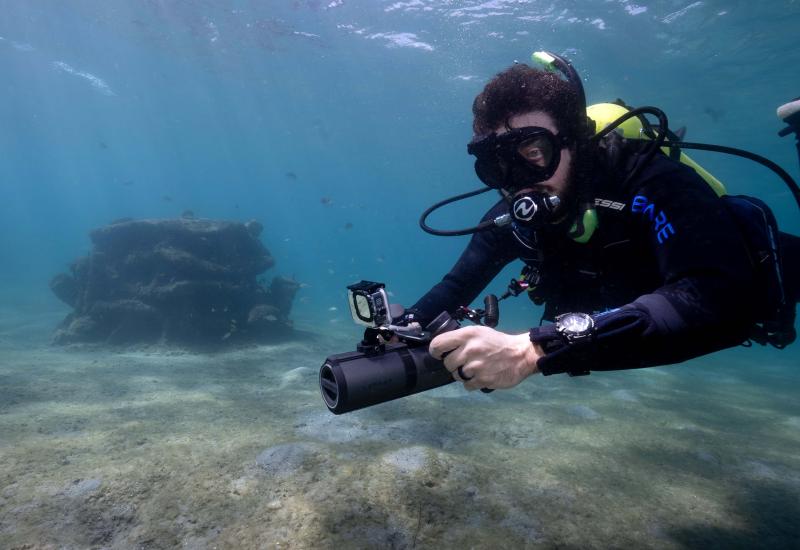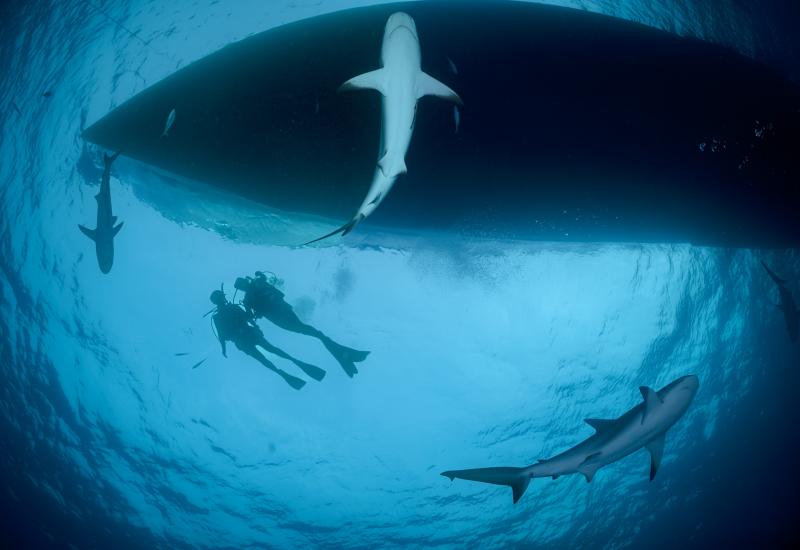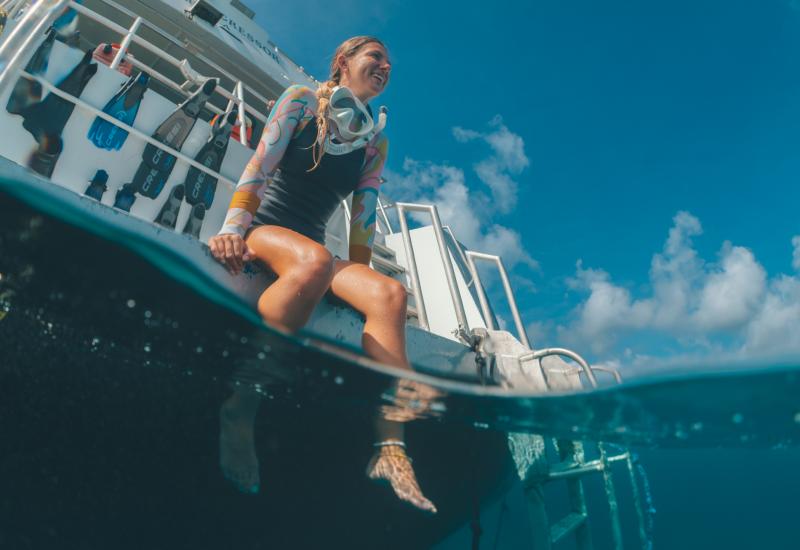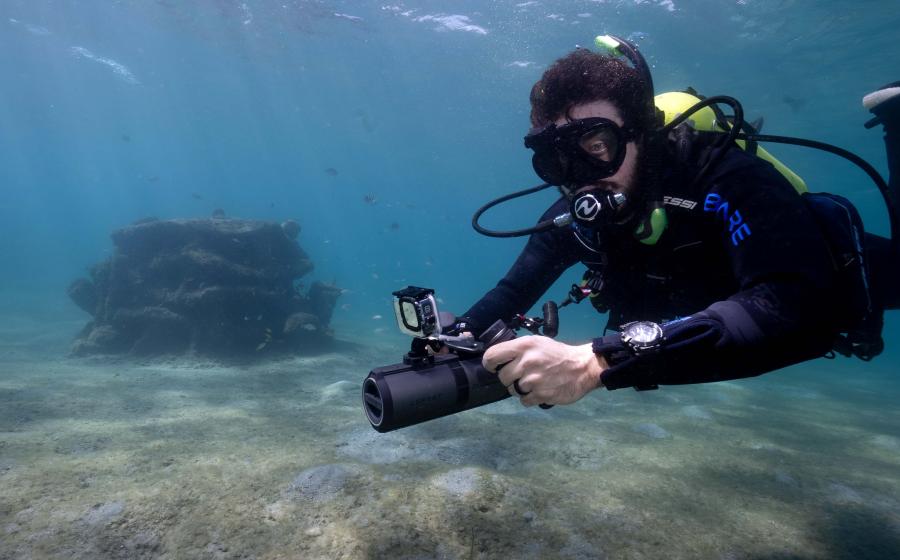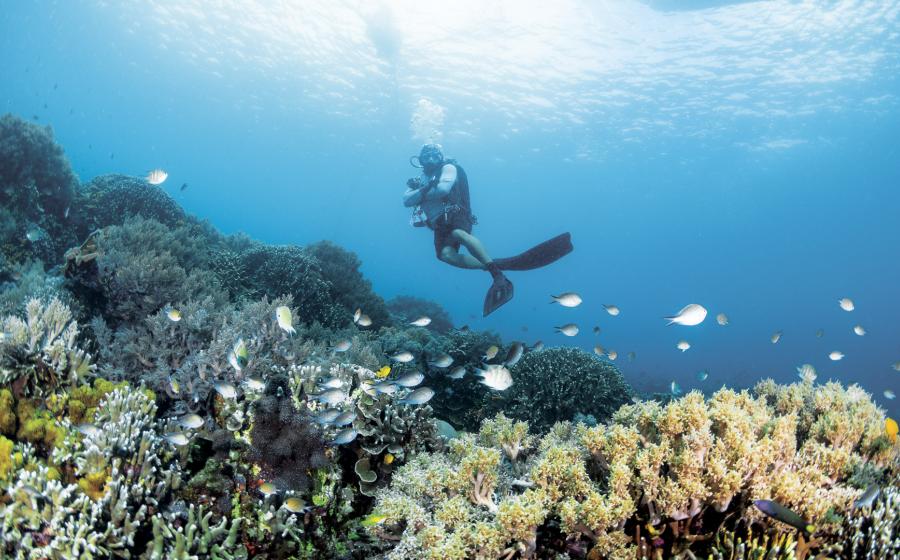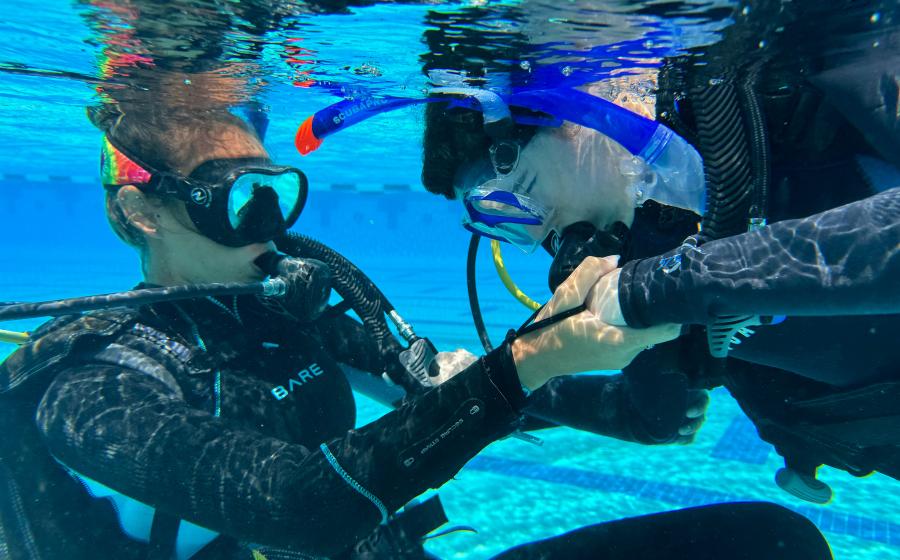Body Glove
The Meistrell boys were born and raised in a small town in Missouri. Bob and Bill were identical twins but born on separate days. Throughout their entire childhood the boys were always interested in the water. When the twins were four years old their father died, so their mother had to raise seven children by herself. The boys' older brother, Joe, was a lifeguard at the local pool. With Joe's help Bob and Bill became accomplished swimmers. "We just joined the Boy Scouts every year to swim for them, then would quit after the meet." The boys were interested in deep sea diving, so at the age of fourteen they built their own diving helmet. "We got a five gallon vegetable can, cut out the bottom and had a guy solder shoulder pads on it so it didn't cut into us. We put a piece of glass on the front and used tar as a seal around the glass. We had enough sense to put in a check valve, made from a marble and a spring so the air wouldn't come out when we stopped pumping. One of us would wear this thing in the swimming pool, sit down on the bottom and read magazines, while the other pumped air on the surface with a tire pump. The pump would get so hot that you would have to dip it in the water to cool it off. You'd feel the water coming up to your nose. I can't tell you how many times we had to bail out of that thing. It's a wonder we didn't get air embolism. We used to march around in some of the local lakes at depths of about 15 feet."
In 1944, the Meistrell family packed up and moved to Manhattan Beach, California. Bob and Bill enrolled in Redondo Union High School. After a year and a half the boys transferred to El Segundo High where they took up football and swimming.
The Meistrells fell in love with the ocean despite the pollution problem. "At Manhattan Beach you couldn't swim because it was so polluted," says Bob. They got into surfing just when balsa boards were starting to catch on, and were among the first to apply fiberglass to protect the nose of the foam-filled plywood boards.
During high school the boys bought a genuine diving helmet for $25, after the owner was killed using it. "We marched all over the breakwater with that thing, one at a time while the other would be pumping. There were no wetsuits in those days so we would be freezing. The helmet was just good for looking around. You couldn't lean over and grab anything. Maximum depth was 20 feet. There was clear water with a white sandy bottom and lots of fish. A whole other world!"
After graduation the Meistrell twins became full-time lifeguards, but Bill was soon drafted into the Army. Bob, thinking he would be deferred because of his broken back sustained while playing football, was drafted in the Army two months after he was married. They said, "You're warm, you're breathing, you're in the Army now." Bill went to Korea where he received a Bronze Star and Bob stayed in the reception center in Monterey. "I lived in Santa Cruz and hitchhiked back and forth to the Monterey Army Base. I lived one block from the beach at Pleasure Point and surfed by car light without a wetsuit almost nightly. There were no other people, but a little seal would sometimes jump up on my board and surf into the beach with me at the river mouth."
Bob and Bill needed to find a way to combat California's cold water. They tried a variety of ideas, including electrically heated flyers' suits from war surplus, but those would burn up and wool sweaters lasted only as long as they were dry, which wasn't too long. Finally in 1953, they found some insulation material, which was used in the back of refrigerators. This material was called neoprene and was used to make the first practical suits.
In 1953, Bill's friend, Bev Morgan, a Los Angeles County lifeguard who later went on to successfully manufacture a line of commercial dive gear, offered Bill a share of his local sports shop called Dive N' Surf. Bev owned the shop with Hap Jacobs, who later pioneered the modern surfboard, but Jacobs wanted out so Bill took Bev up on his offer only if Bob could come on board too. Bev agreed and Bob and Bill borrowed $1800 from their mom and each bought one third of the business. "Business started out slow. The first day I thought, "Wow, this business is really taking off!" Slowly but surely business did get better, although during the first few years bringing in $100. a day was a goal, not a reality. To keep themselves afloat the twins continued lifeguarding on a part-time basis. In 1957 the Meistrell brothers were able to buy out their remaining partner.
In 1955, Bob was part of the UICC (Underwater Instructors Certification Course) class #1. These people were the first people in the world that were certified scuba instructors. Some of the other people in the class were: Bev Morgan, Al Tillman, Ramsey Parks, Andy Rechnitzer, Bill Walker, E.R. Cross and Herb Barthels. Bob's certification number is 1UICC #13.
The Meistrell brothers also owned a company called Dive N' Surf Marine Photography. Here they did commercial diving down to 225 feet on straight air and used to swim through 1/2 mile salt water intake pipes for Southern California Edison Company. Their interest went even deeper however, submarines! Bob and Bill are involved in a company called Undersea Graphics. The company has a single man, 750 foot capability sub and a 2 man 2000 foot capability sub. They do pipeline inspection and recover objects lost in deep water.
From the start, Bob and Bill, made a healthy sideline business out of manufacturing and selling wetsuits. In the early days wetsuits were not used for surfing. Still the Meistrells were grateful for any extra sales and happily designed and tailored their own brand of wetsuits. In the beginning the wetsuits were named Thermocline. The Meistrells didn't think this was a great name so they hired a marketing consultant, Duke Boyd. Duke asked about the characteristics of the suits and Billy said, "They fit like a glove," so Duke came up with the name Body Glove. "We paid him $200 to get a logo designed. He found a guy who did it for $35. Years later, this guy's son came into the store and said "My dad did that." He was living in Hawaii and we sent him a whole bunch of Body Glove stuff.
Throughout the years Body Glove wetsuit sales grew bigger and bigger and eventually the twins bought a building just to manufacture their popular Body Glove wetsuits. Not only were they making wetsuits for surfing and diving, but the other water recreational sports also. The business wasn't the only thing growing, the families were growing too. Bob now has three sons, Robbie, Randy and Ronnie and Bill has a son Billy, and a daughter Julie. The children grew up with the business and throughout their childhood and adult years held several different jobs within the company. "We all started out sweeping floors," says Ronnie. "We grew up with the business." By the early 80's, the company reached a point where it had supported both families comfortably for 30 years. By 1982, Dive N' Surf's sales topped $1.7 million, Body Glove was selling $2 million a year. Throughout the following years the children (2nd generation) received more and more control of the marketing of the company. Now Body Glove sales have reached an all time high and the company is recognized worldwide for its quality products and outstanding customer service.
In 1990, Bob and Bill were inducted into both the Diving Hall of Fame and the Pioneers of Surfing. "We were among the first surfers. We spent years and years along the beaches. We were selected not because we were great surfers, but the ones that brought out the wetsuits. Without them there would of been a lot of drownings."
At age 68, the brothers show no signs of slowing down. They still dive regularly and oversee the family's business empire. On most weekends, they cruise the coastline in their 70 foot yacht, The Disappearance, decorated with huge Body Glove logos. Despite the farm boy appeal, everybody now knows them as friendly yet savvy, and above all, honest businessmen. Bob sums it up: "Billy and I don't have goals because we haven't figured out what we want to do yet."

Body Glove Logo
Details
Information: 201 Herondo StRedondo Beach, CA 90277
Phone: Phone: 310.374.3441
Email: pr@bodyglove.com
Website: http://www.bodyglove.com
The Meistrell boys were born and raised in a small town in Missouri. Bob and Bill were identical twins but born on separate days. Throughout their entire childhood the boys were always interested in the water. When the twins were four years old their father died, so their mother had to raise seven children by herself. The boys' older brother, Joe, was a lifeguard at the local pool. With Joe's help Bob and Bill became accomplished swimmers. "We just joined the Boy Scouts every year to swim for them, then would quit after the meet." The boys were interested in deep sea diving, so at the age of fourteen they built their own diving helmet. "We got a five gallon vegetable can, cut out the bottom and had a guy solder shoulder pads on it so it didn't cut into us. We put a piece of glass on the front and used tar as a seal around the glass. We had enough sense to put in a check valve, made from a marble and a spring so the air wouldn't come out when we stopped pumping. One of us would wear this thing in the swimming pool, sit down on the bottom and read magazines, while the other pumped air on the surface with a tire pump. The pump would get so hot that you would have to dip it in the water to cool it off. You'd feel the water coming up to your nose. I can't tell you how many times we had to bail out of that thing. It's a wonder we didn't get air embolism. We used to march around in some of the local lakes at depths of about 15 feet."
In 1944, the Meistrell family packed up and moved to Manhattan Beach, California. Bob and Bill enrolled in Redondo Union High School. After a year and a half the boys transferred to El Segundo High where they took up football and swimming.
The Meistrells fell in love with the ocean despite the pollution problem. "At Manhattan Beach you couldn't swim because it was so polluted," says Bob. They got into surfing just when balsa boards were starting to catch on, and were among the first to apply fiberglass to protect the nose of the foam-filled plywood boards.
During high school the boys bought a genuine diving helmet for $25, after the owner was killed using it. "We marched all over the breakwater with that thing, one at a time while the other would be pumping. There were no wetsuits in those days so we would be freezing. The helmet was just good for looking around. You couldn't lean over and grab anything. Maximum depth was 20 feet. There was clear water with a white sandy bottom and lots of fish. A whole other world!"
After graduation the Meistrell twins became full-time lifeguards, but Bill was soon drafted into the Army. Bob, thinking he would be deferred because of his broken back sustained while playing football, was drafted in the Army two months after he was married. They said, "You're warm, you're breathing, you're in the Army now." Bill went to Korea where he received a Bronze Star and Bob stayed in the reception center in Monterey. "I lived in Santa Cruz and hitchhiked back and forth to the Monterey Army Base. I lived one block from the beach at Pleasure Point and surfed by car light without a wetsuit almost nightly. There were no other people, but a little seal would sometimes jump up on my board and surf into the beach with me at the river mouth."
Bob and Bill needed to find a way to combat California's cold water. They tried a variety of ideas, including electrically heated flyers' suits from war surplus, but those would burn up and wool sweaters lasted only as long as they were dry, which wasn't too long. Finally in 1953, they found some insulation material, which was used in the back of refrigerators. This material was called neoprene and was used to make the first practical suits.
In 1953, Bill's friend, Bev Morgan, a Los Angeles County lifeguard who later went on to successfully manufacture a line of commercial dive gear, offered Bill a share of his local sports shop called Dive N' Surf. Bev owned the shop with Hap Jacobs, who later pioneered the modern surfboard, but Jacobs wanted out so Bill took Bev up on his offer only if Bob could come on board too. Bev agreed and Bob and Bill borrowed $1800 from their mom and each bought one third of the business. "Business started out slow. The first day I thought, "Wow, this business is really taking off!" Slowly but surely business did get better, although during the first few years bringing in $100. a day was a goal, not a reality. To keep themselves afloat the twins continued lifeguarding on a part-time basis. In 1957 the Meistrell brothers were able to buy out their remaining partner.
In 1955, Bob was part of the UICC (Underwater Instructors Certification Course) class #1. These people were the first people in the world that were certified scuba instructors. Some of the other people in the class were: Bev Morgan, Al Tillman, Ramsey Parks, Andy Rechnitzer, Bill Walker, E.R. Cross and Herb Barthels. Bob's certification number is 1UICC #13.
The Meistrell brothers also owned a company called Dive N' Surf Marine Photography. Here they did commercial diving down to 225 feet on straight air and used to swim through 1/2 mile salt water intake pipes for Southern California Edison Company. Their interest went even deeper however, submarines! Bob and Bill are involved in a company called Undersea Graphics. The company has a single man, 750 foot capability sub and a 2 man 2000 foot capability sub. They do pipeline inspection and recover objects lost in deep water.
From the start, Bob and Bill, made a healthy sideline business out of manufacturing and selling wetsuits. In the early days wetsuits were not used for surfing. Still the Meistrells were grateful for any extra sales and happily designed and tailored their own brand of wetsuits. In the beginning the wetsuits were named Thermocline. The Meistrells didn't think this was a great name so they hired a marketing consultant, Duke Boyd. Duke asked about the characteristics of the suits and Billy said, "They fit like a glove," so Duke came up with the name Body Glove. "We paid him $200 to get a logo designed. He found a guy who did it for $35. Years later, this guy's son came into the store and said "My dad did that." He was living in Hawaii and we sent him a whole bunch of Body Glove stuff.
Throughout the years Body Glove wetsuit sales grew bigger and bigger and eventually the twins bought a building just to manufacture their popular Body Glove wetsuits. Not only were they making wetsuits for surfing and diving, but the other water recreational sports also. The business wasn't the only thing growing, the families were growing too. Bob now has three sons, Robbie, Randy and Ronnie and Bill has a son Billy, and a daughter Julie. The children grew up with the business and throughout their childhood and adult years held several different jobs within the company. "We all started out sweeping floors," says Ronnie. "We grew up with the business." By the early 80's, the company reached a point where it had supported both families comfortably for 30 years. By 1982, Dive N' Surf's sales topped $1.7 million, Body Glove was selling $2 million a year. Throughout the following years the children (2nd generation) received more and more control of the marketing of the company. Now Body Glove sales have reached an all time high and the company is recognized worldwide for its quality products and outstanding customer service.
In 1990, Bob and Bill were inducted into both the Diving Hall of Fame and the Pioneers of Surfing. "We were among the first surfers. We spent years and years along the beaches. We were selected not because we were great surfers, but the ones that brought out the wetsuits. Without them there would of been a lot of drownings."

..
At age 68, the brothers show no signs of slowing down. They still dive regularly and oversee the family's business empire. On most weekends, they cruise the coastline in their 70 foot yacht, The Disappearance, decorated with huge Body Glove logos. Despite the farm boy appeal, everybody now knows them as friendly yet savvy, and above all, honest businessmen. Bob sums it up: "Billy and I don't have goals because we haven't figured out what we want to do yet."
Details
Information: 201 Herondo StRedondo Beach, CA 90277
Phone: Phone: 310.374.3441
Email: pr@bodyglove.com
Website: http://www.bodyglove.com

